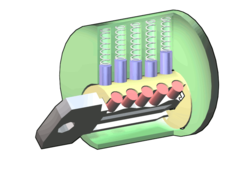
Partly prompted by a Penn and Teller episode, and partly by a post written by my friend Tristan, I have been thinking about conspiracy theories today. On what basis can we as individuals accept or refute them? Let’s take some examples that Penn and Teller raise: the reality of the moon landings, the nature of the JFK assassination, and the nature of the September 11th attacks. It should be noted that this is the worst episode of theirs I have ever seen. It relies largely upon arguments based on emotion, backed by the testimony of people to whom Penn and Teller accord expert status, rather than a logical or empirical demonstration of why these theories should be considered false.
Normally, our understanding of such phenomena is mediated through experts. When someone credible makes a statement about the nature of what took place, it provides some evidence for believing it. Penn and Teller amply demonstrate that there are lots of crazy and disreputable people who believe that the moon landing was faked, some strange conspiracy led to the death of JFK, and CIA controlled drones and explosives were used to carry out the September 11th attacks. That said, it hardly disproves those things. Plenty of certifiably insane people believe that the universe is expanding, that humans and viruses have a common biological ancestor, and that any whole number can be generated by adding powers of two (365 = 2^8 + 2^6 + 2^5 + 2^3 +2^2 + 2^0). That doesn’t make any of those things false.
We really have three mechanisms to work with:
- Empirical evidence
- Logical reasoning
- Heuristic methods
As individuals confronted with questions like those above, we almost always use the third. While those with a powerful telescope and the right coordinates could pick out all the junk we left on the moon, most people lack the means. Likewise, those with a rifle, a melon, and some time can learn the physics behind why Kennedy moved the way he did when he was shot, despite Oliver Stone‘s theories to the contrary. Finally, someone with some steel beams, jet fuel, and mathematical and engineering knowledge can model the collapse of the twin towers as induced by heat related weakening of steel to their heart’s content. Normally, however, we must rely upon experts to make these kinds of judgements for us, whether on the basis of sound technique or not.
Logical reasoning is great, but when applied strictly cannot get us very far. Most of what people call ‘logic’ is actually probabalistic reasoning. Strict logic can tell us about things that are necessary and things that are impossible. If every senior member of the American administration is controlled by an alien slug entity, and all alien slug entitites compel their hosts to sing “Irish Eyes are Smiling” once a day, we can logically conclude that all members of the American administration sing “Irish Eyes are Smiling” every day. Likewise, if all bats are bugs, all non-bugs must be non-bats. Entirely logically valid, but not too useful.
A heuristic reasoning device says something along the lines of: “In the more forty years or so since the moon landing, nobody has brought forward credible evidence that they were faked. As such, it is likely that they were not.” Occam’s razor works on the same kind of principle. This is often the best kind of analysis we can manage as individuals, and it is exactly this that makes conspiracy theories so difficult to dislodge. Once you adopt a different logic of probability, for instance one where certain people will stop at nothing to keep the truth hidden, your probabilistic reasoning gets thrown out of whack.
How, then, should we deal with competing testimony from ‘experts’ of various sorts, and with the fallout of our imperfect ability to access and understand the world as individuals? If there was a pat and easy answer to this question, it would be enormously valuable. Alas, there is not, and we are left to try and reach judgments on the basis of our own, imperfect, capabilities.
PS. For the record, I believe that the moon was almost certainly walked upon by humans, that Oswald quite probably shot John F. Kennedy on his own initiative, and that the airplanes listed in the 9/11 report as having crashed where they did actually did so. My reasons for believing these things are almost entirely heuristic.






